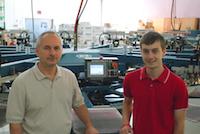If you’re either very new or very old in this business, you’ll have come across four-color process (4CP) printing. For those who are very experienced (20 years or more), 4CP or CMYK printing was the only real way of achieving photo-realistic reproduction. For more than 150 years, this was the way all full-color printing was done for all printing processes.
4CP history
Right from the beginning, I’d like to clarify a major misconception about process color. It may be referred to as full-color printing but, in reality, it is far from full color. We can reproduce a wide range of colors, but nowhere near what we see with our eye. A healthy human will see somewhere between six and 10 million colors and tones depending on age and gender. The very best printing process will reproduce about 750,000 colors. At best, we will reproduce about 1,000 colors and tones when printing on fabric. Sorry, that’s the best we can do and it won’t get better unless we add more colors to the sequence. This is why simulated process became so popular.
With the advent of digital in the early ‘90s, process-color printing began to fall out of favor. This was primarily because it was so difficult to control. In fact, Joe Clarke’s 1986 book “Control Without Confusion” has been considered the definitive bible for this type of printing and went a long way toward introducing the variables and how to control them. I was fortunate enough to have provided the subject art and the actual project printing for that work. For those new to the industry, CMYK or process color reproduction is experiencing somewhat of a renaissance. For one thing, it’s easier to separate true process color than it is for simulated process. A second reason why the interest in 4CP is returning is the rise of direct-to-substrate/garment printing (DTS or D2). All digital printing is CMYK or true process color reproduction. It provides the opportunity to deliver proofs and short runs of a process color image and then have the main, high-volume run done with screen. This dual reproduction of the image by two different printing methods opens the door for the return of true process color. The challenge is to make sure the color is consistent between the two methods. It should also be noted that while we refer to this method as four-color process, be aware that process color is almost never printed with just four colors. It’s common to add a highlight white to the sequence, even when printing on white shirts. It’s also quite common to add an additional red, blue, green, or purple if the image has strong variations of one of these colors in it. So, the most common approach to process color is really either five color process (CMYK plus white) or six color process (CMYK plus white plus color.) For inkjet or digital reproduction, it’s very common to have even more. Some of the more common variations are CMYK plus four whites and CMYK, Lc,Lm,Ly, Lbk where L = a lighter version of the primary CMYK colors. This helps control the very light grays, pastels and tertiary colors.
Read the rest of the article in Printwear Magazine

About the Author
- Email Address mark.coudray@coudray.com
- Phone 805-541-1521
Mark is founder and President of Coudray Serigraphics, a textile screen printing company and Coudray Graphic Technologies, a digital imaging and prepress supplier to the industry. He was inducted into the Academy of Screen Printing Technology in 1989 and has served as Chairman of the ASPT twice. In addition, Mark is the recipient of 18 SGIA Golden Image Awards, 2 Swormstedt Awards, Magnus Award, and the Parmele Award (2001). He is past SGIA Chairman (2000). He has served a total of 24 years as an SGIA Director. Mark is a noted industry author with Screen Printing, Impressions, Print Wear, Images, and other trade publications with over 275 articles, columns, and technical papers as well as an industry presenter at tradeshows, conventions, and technical symposiums. He is best known for his extensive work in controlling color halftone printing, quality, and production management of the screen printing process.



